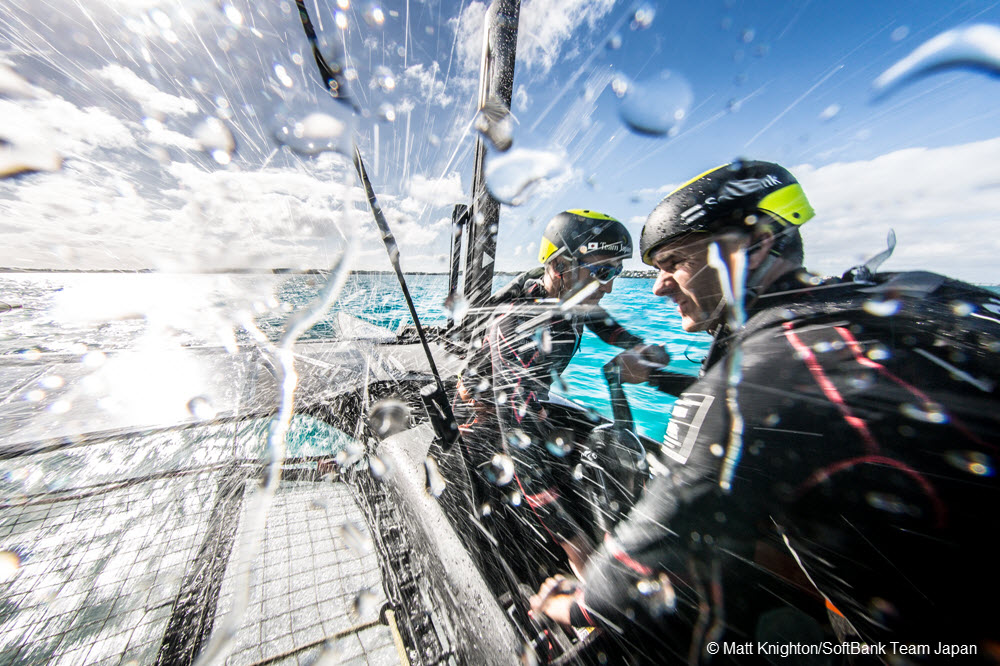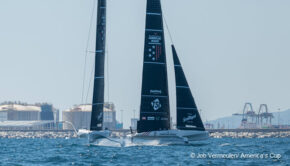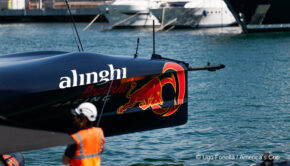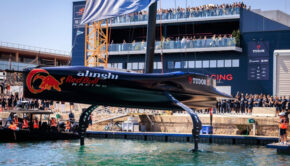A Kinder, Friendlier America’s Cup
Published on January 27th, 2016
There was a time in America’s Cup history when maximum energy was exerted by the Defender to defeat their Challengers. But these are now friendlier times, as is reported in this update from Matt Knighton, Communications Director for SoftBank Team Japan…
America’s Cup challenger SoftBank Team Japan spared little time hitting the water in 2016 sailing for the first time their new AC45 Sport boat on the Great Sound in Bermuda this past weekend.
The launch of this new testing platform acquired from ORACLE TEAM USA marks a new phase in the design race for the team who, remarkably, began their America’s Cup challenge less than 8 months ago.
“In May it was Fuku and myself and now here we are with over 30 people on the team,” said team CEO and skipper Dean Barker. “It’s nice to see all the planning taking shape into something we can touch and feel. You need to start somewhere and that starting point was today for us.”
The AC45 Sport boat is a customized next-generation version of the one-design AC45F the team races in the Louis Vuitton America’s Cup World Series. Essentially a testing platform to prove new technology and design, the AC45 Sport features hydraulics and control systems that allow the sailors greater command of the wing sail and foils that help the yacht reach speeds of over 40 mph.
The data and performance analysis collected from this new test boat will directly impact the design of the team’s future 15-meter AC Class race yacht – the new class of boat the team will build in late 2016 that will be raced in the 2017 America’s Cup.
“We’re very fortunate to have access to the amazing technology in the Oracle design package. The level and skill of the team there is indisputable. For us it’s a great starting point and anything that we can take, learn, and develop from them gives us a great opportunity to be successful. We just have to make sure we’re structured in our approach and use the time we have to our advantage.”
Paramount to driving this new testing phase is team Technical Director, Nick Holroyd. With his expertise in computational fluids and appendage design, he’ll lead much of the experimental development process that will enable the boats to foil more efficiently and with more control.
“First, there’s a lot of work to assess the package we’ve got,” explained Nick. “Fortunately, the design space is narrowed down – appendages, control systems, wing control, ergonomics, how to deal with the shortage of power on the boat in terms of hydraulic power from the boys grinding – those are all areas teams know they really need to focus on at this point.”
Specifically, dagger board foil design will take the priority seat in the development phase as the team narrows down which shapes will go into production for their future AC Class yacht.
“The way the protocol works is you’re only ever allowed to fit 4 boards [2 sets] into the AC Class. Depending on how you want to design those – for wind range, sea state, stability, etc. – then the first set you launch the boat with will be one of your racing sets. You’re focusing on both the refinement and revolution game at this point so the pressure is on.”
Add to this the fact that contractors have specific build windows in which to construct these underwater carbon fiber wings and it becomes clear that every practice session on the water is precious.
“The decision date looms pretty fast when you consider typical build time for new dagger boards is 3 months. The clock is very much ticking.”










 We’ll keep your information safe.
We’ll keep your information safe.